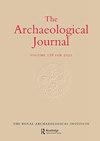Life, death and rubbish disposal in Roman Norton, North Yorkshire. Excavations at Brooklyn House 2015-16
IF 0.8
0 ARCHAEOLOGY
引用次数: 2
Abstract
drinking customs. Based on its local context the authors propose that the hoard was deposited between c.AD 45–60/61, perhaps by a member of the local native elite. Various theories for its deposition have been proposed previously, some more plausible than others, with the authors leaning towards a votive explanation, which does seem likely given the proximity of the temple. Here they suggest that this act may have been conceived as a deliberate repudiation of the newly emerged cultural practices of the immediate postConquest period in the aftermath of the Boudiccan rebellion, a convincing theory given the deliberately fragmented condition in which it was deposited. It is a credit to the original finder of the hoard that we know so much about its discovery and it is good to finally see this publication as there has been little easily accessible information available previously. Although slim in size and limited in its scope the study nonetheless makes a worthwhile contribution to the study of the fascinatingly complex cultural transitions of the mid-first century AD in south-east Britain and the developing material culture of this period.北约克郡罗曼诺顿的生命、死亡和垃圾处理。布鲁克林住宅挖掘2015-16
饮酒习俗。根据其当地背景,作者提出,该窖藏是在公元45-60/61年之间沉积的,可能是当地的一名精英。关于它的沉积,之前已经提出了各种各样的理论,其中一些比其他的更可信,作者倾向于一个许愿的解释,考虑到神庙的邻近,这似乎是可能的。在这里,他们提出,这一行为可能被认为是对布迪卡叛乱之后的征服后时期新出现的文化习俗的蓄意否定,这是一个令人信服的理论,因为它被放置在故意分散的条件下。我们对这批宝藏的发现有了如此多的了解,这要归功于最初的发现者,而且很高兴终于看到了这份出版物,因为以前几乎没有什么容易获得的信息。尽管篇幅狭窄,范围有限,但这项研究对研究公元1世纪中叶英国东南部迷人而复杂的文化转型以及这一时期物质文化的发展做出了有价值的贡献。
本文章由计算机程序翻译,如有差异,请以英文原文为准。
求助全文
约1分钟内获得全文
求助全文

 求助内容:
求助内容: 应助结果提醒方式:
应助结果提醒方式:


